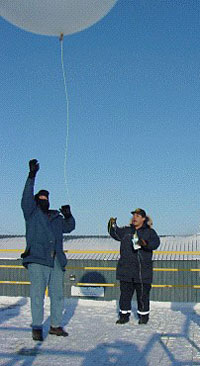Increased Weather Balloon Soundings Begin at Barrow
Published: 31 March 2006

In April, ARM operations staff at the North Slope of Alaska will begin launching balloon-borne sounding systems—better known as weather balloons—two times per day from the Great White Instrument Shelter in Barrow. Each weather balloon is equipped with a radiosonde package for measuring air pressure, temperature, and humidity. ARM operations personnel will launch the balloons at 6 a.m. and 6 p.m. GMT, offsetting launches from the National Weather Service (NWS) research station in Barrow by 6 hours. Beginning in May, global positioning system (GPS) sondes will be used that provide profiles of wind speed and direction as well.
In November 2005, both the ARM Cloud Properties and Instantaneous Radiative Flux Working Groups supported the proposal to increase the frequency of balloon soundings at Barrow from once to twice each day. This plan was approved by the ARM Science Team Executive Committee, and activities to purchase additional supplies and labor commenced. To keep costs to a minimum and ease pressure on the delivery schedule for the new GPS sondes, an implementation schedule was developed for the twice-daily launches starting with the original sondes for the first month, and then to begin using the newly purchased GPS sondes. The additional wind data from the soundings will provide climate scientists with more information about atmospheric conditions in the sensitive Arctic environment.
The ARM Climate Research Facility is a DOE Office of Science user facility. The ARM Facility is operated by nine DOE national laboratories, including .
Keep up with the Atmospheric Observer
Updates on ARM news, events, and opportunities delivered to your inbox
ARM User Profile
ARM welcomes users from all institutions and nations. A free ARM user account is needed to access ARM data.


















